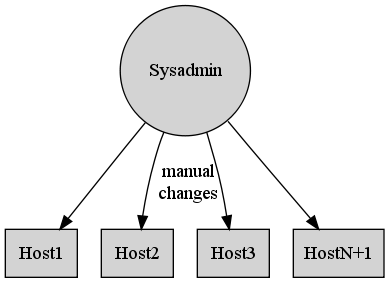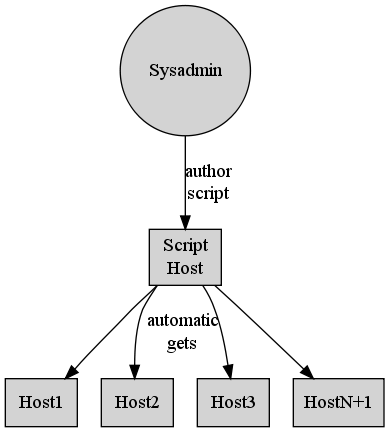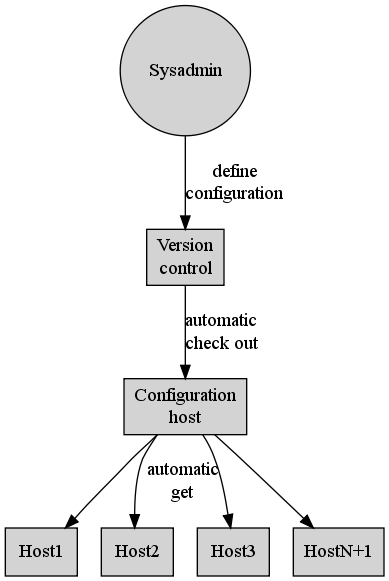Enterprise system administration using configuration management
To maintain the large quantity of servers typically found in enterprise organizations, systems administration must move beyond manual and custom scripts toward a centralized configuration management service. This move can save an organization considerable time and money.
Introduction Stages of configuration management Manual stage Custom automation stage Dedicated service stage Practical Examples Security Automated builds Host replacement Self healing Savings Perception of control
Introduction
When talking about system administration in this paper I am referring to the act of maintaining UNIX hosts and their services. System administration is more than this but for this paper I will discuss only a subset of system administration skills which I call configuration management. Configuration management is the act of creating new hosts and maintaining existing ones and their services according to the specifications of an organization's policies.
Stages of configuration management
As an organization adds more and more hosts, both physical and virtual, its system administrators must spend more and more time ensuring that all hosts comply with policy. This results in an explosive demand in manpower. Organizations can often find themselves constantly falling behind, never able to finish projects on time or neglecting less visible infrastructure in order to deliver other highly visible projects.
In order to prevent this situation the organization must grow its methods of configuration management. The growth of configuration management usually has three distinct phases: manual, custom automation, and dedicated service. Few organizations grow beyond the manual stage. Fewer still beyond custom automation.
Manual stage
Management the manual way (see figure 1) involves copying files and issuing manual commands repeatedly to every host. With this method a simple three minute change applied to sixty hosts becomes a two hour job. Worse still, such changes are static. There is no way to know if changes are still in place without a manual audit.
Figure 1: Manual configuration management

Custom automation stage
Some administrators develop a kit of custom scripts (see figure 2) and files that are deployed from host to host by a further set of custom scripts and services. This method is effective by allowing the administrator to automate a change across all hosts but does not scale well. More and more scripts must be created and maintained as the number of hosts and services grow. Trying to maintain an ever growing collection of dissimilar custom scripts can become a project of its own. Further, new members of the system administrator team will have to spend time learning this entirely custom environment.
Figure 2: Custom configuration management scripted-admin.png

Dedicated service stage
A dedicated configuration management service (see figure 3) offers the time savings of automated custom scripts but in a more maintainable way. A Dedicated service has built in methods for handling many configuration changes that eliminate the need for custom scripts. Also, since this service is not entirely custom it is possible to find new team members with previous experience.
Figure 3: Dedicated configuration management config-admin.png

Dedicated configuration management allows system administrators to control servers from a central location. Administrators are able to make a single manual change and have that change automatically deployed to all desired hosts across the network. The configuration management service continuously ensures that these changes are applied. This can save an organization time and money. All changes in a configuration management system are version controlled. This means that all change history is recorded for auditing and disaster recovery.
Practical Examples
The following are practical examples of how configuration management can save an organization countless resources.
Security
A tedious and constantly changing security policy must be maintained across some or all hosts. Many aspects of a security policy define how a service or host should be configured. A typical security policy may touch upon PAM files, log file permissions, log history retention, home directory permissions and SSH configuration to name a few. A configuration management service can be used to maintain all of these examples and more. Using this service ensures that hosts meet the current policy requirements. New hosts will have the policy automatically applied. Policy changes need only be defined once then applied automatically to all current and future hosts.
All configurations are stored in the configuration management service's master files location. The master files are version controlled. With version control one can easily determine every line that has been changed, when that change was checked in and by whom.
Automated builds
Jumpstart or kickstart services can only accomplish so much. Final configurations are typically done by hand or by a collection of custom scripts. A configuration management service can apply all additional custom policy changes to the host automatically.
Host replacement
Host replacement either for end of life hosts or disaster recovery can be more automated by using the configuration management service. All configurations of the original host are pointed toward the new host where they will be applied automatically.
Self healing
Some organizations run services to ensure that services and processes are running, or sometimes not running, on selected hosts. These services are often given the name network management or network monitoring. Configuration management cannot replace the essential service of network monitoring but it can augment it.
Configuration management services can ensure that configuration files are correct and whether or not services are running. Network monitoring services typically send notification when services fail. Configuration management services can actually make corrections preventing the need for notification.
Finally it is also possible for a network monitoring service to automatically activate a configuration management service when it detects a failure. This corrective action may repair the failure, again without the need for notification.
Savings
With manual tasks automated staff will now have more time to focus on important projects. Large tasks like security audits or patch updates can now be automated across all hosts. (See table 1)
Now consider service outages. Suppose that the configuration management”s self healing nature prevents just two outages per year. How many employees had to work, or could not work during those outages? Typically even a small outage can cost an organization a considerable amount of lost time.
